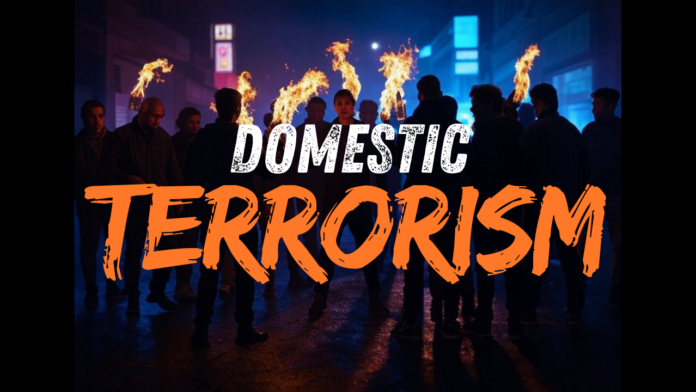Learn how specific activist behaviors challenge the distinction between activism and domestic terrorism in today’s climate of dissent.
Psalm 11:5: “The Lord tests the righteous, but his soul hates the wicked and the one who loves violence.”
Discuss article in our forum here
Activism Crossing the Line
In recent years, the line between activism and extremism has blurred, particularly among some leftist activist groups whose tactics have escalated beyond protest into what could reasonably be called domestic terrorism. While activism is a cornerstone of free societies, certain actions—arson, vandalism, and targeted intimidation—fit legal and practical definitions of terrorism when they aim to instill fear, disrupt public order, or coerce political change. This article explores how specific leftist activist behaviors align with these criteria, challenging the narrative that such acts are mere civil disobedience.
Defining Terrorism
The U.S. Code (18 U.S.C. § 2331) defines domestic terrorism as acts dangerous to human life that violate criminal laws, intended to intimidate or coerce a civilian population, influence government policy through intimidation, or affect government conduct by mass destruction, assassination, or kidnapping. Internationally, the United Nations describes terrorism as acts causing death, injury, or property damage to spread fear for ideological goals. These frameworks provide a lens to evaluate activist conduct, regardless of political leanings.
The Escalation of Tactics
Leftist activism, often rooted in causes like climate justice, economic equality, or anti-corporate sentiment, has a history of peaceful marches and sit-ins. Yet, recent incidents reveal a shift toward violence and destruction. Take the wave of attacks on Tesla facilities in 2024 and 2025: dealerships firebombed in Oregon, Superchargers torched in Massachusetts, and Cybertrucks set ablaze in Seattle. These weren’t spontaneous outbursts but coordinated strikes, some claimed by shadowy groups like “Dark Storm,” aiming to punish a company seen as a capitalist symbol. The intent wasn’t just to protest Tesla’s existence but to terrorize its workers, owners, and supporters into submission.
Similarly, climate activists have torched logging equipment, sabotaged pipelines, and defaced public infrastructure. In Europe, groups like “Volcano Group” have claimed responsibility for cutting power lines and burning factories, framing their actions as resistance to environmental harm. In the U.S., anti-police activists have hurled Molotov cocktails at precincts and ambushed officers, acts echoing the 2020 riots that left cities smoldering. These incidents go beyond voicing dissent—they weaponize fear to force societal shifts.
Intent to Intimidate
What distinguishes these acts as terrorism is their deliberate aim to intimidate. When a Tesla showroom is riddled with bullet holes or a pipeline explodes, the message isn’t just “we disagree”—it’s “comply or face chaos.” The public isn’t merely inconvenienced; it’s made to feel vulnerable, with everyday activities like charging a car or walking past a dealership turned into potential risks. This aligns with the legal threshold of coercing civilians or governments through fear, a hallmark of terrorism.
Contrast this with traditional activism: a march disrupts traffic but doesn’t burn bridges—literally or figuratively. The shift to property destruction and violence signals an intent to destabilize, not just to dialogue. When activists boast online about “taking down” corporations or “punishing” politicians, they reveal a goal of psychological domination, not persuasion.

Ideological Underpinnings
Leftist extremism often cloaks itself in moral superiority, claiming the ends justify the means. Destroying a Tesla isn’t just vandalism—it’s “saving the planet” from a billionaire’s hubris. Sabotaging infrastructure isn’t chaos—it’s “justice” for marginalized communities. This ideological zeal mirrors the fervor of recognized terrorist groups, where higher causes excuse collateral damage. The difference lies in branding: where Al-Qaeda invokes religion, these activists invoke progressivism, yet both rationalize violence as noble.
Economic and Social Disruption
The ripple effects of these acts amplify their terroristic nature. Arson at a Supercharger doesn’t just cost Tesla money—it strands drivers, spikes repair costs, and chills investment in electric vehicles. Attacks on police or government buildings erode public safety, leaving communities on edge. Economically, the damage—estimated in the millions from 2020 riots alone—burdens taxpayers and businesses, while socially, it fosters a climate of distrust. This mass disruption fits the “mass destruction” clause of terrorism statutes, even if lives aren’t directly taken.
The Counterargument—and Its Limits
Critics argue these acts don’t qualify as terrorism because they lack the scale or body count of, say, 9/11. They’re “protests gone too far,” not premeditated terror. Yet this overlooks intent and impact. A firebomb doesn’t need to kill to terrify; it just needs to burn brightly enough to haunt its targets. Legal systems don’t require mass casualties—only the intent to intimidate or coerce, which these actions demonstrably possess. Calling them mere activism downplays their chilling effect on free society.
A Call for Clarity
Labeling leftist activist violence as terrorism isn’t about silencing dissent—it’s about recognizing when dissent becomes destruction. The First Amendment protects speech, not Molotovs. As federal agencies like the ATF and FBI investigate these incidents, they’re already treating them as serious threats, not petty crimes. Designating such acts as domestic terrorism could unlock resources to prevent them, from better surveillance to stricter penalties, while sending a message: ideology doesn’t excuse terror.
In a democracy, change comes through ballots, not blasts. When leftist activists choose the latter, they don’t just break windows—they break the social contract. That’s not activism. That’s terrorism.
Government Response
Trump’s Stance
On March 11, 2025, during a White House event with Elon Musk, Trump explicitly said he would classify violence against Tesla dealerships as domestic terrorism. He stated, “I will do that,” when asked about labeling perpetrators as domestic terrorists, adding, “They’re harming a great American company,” and promised severe consequences like “going through hell” for those caught (Reuters, March 12, 2025; TechCrunch, March 11, 2025). This came amid a wave of Tesla-related incidents, including arson, following Musk’s role in the Department of Government Efficiency (DOGE).
Bondi’s Confirmation
On March 18, 2025, Attorney General Pam Bondi echoed this, calling the “swarm of violent attacks on Tesla property” — specifically citing arson and vandalism — “nothing short of domestic terrorism.” She vowed to impose “severe consequences” and investigate not just perpetrators but also potential coordinators or funders (ABC News, March 19, 2025; New York Times, March 18, 2025). This followed a targeted fire in Las Vegas that damaged five Tesla vehicles, among other incidents.
Federal Investigations
The FBI and ATF are actively probing several Tesla fire cases as potential terrorism. For instance, the Las Vegas incident on March 18, 2025, is under review by the FBI’s Joint Terrorism Task Force, with Special Agent Spencer Evans noting “hallmarks” like political agendas and violence that align with terrorism (The Guardian, March 19, 2025; Fox News, March 18, 2025). Similar investigations are underway for fires in Kansas City and elsewhere.
Context of Labeling
While “domestic terrorism” isn’t a standalone federal charge, the U.S. Code (18 U.S.C. § 2331) defines it as acts dangerous to human life, violating laws, and intended to intimidate or coerce civilians or government for political ends. Tesla fires, like those involving Molotov cocktails in Oregon and South Carolina, fit this if proven politically motivated—e.g., tied to Musk’s DOGE cuts or Trump ties. Perpetrators would face charges like arson or weapons offenses, enhanced by terrorism considerations.
Not Universal
Not all Tesla fires are automatically labeled terrorism. The Seattle fire on March 9, 2025, damaging four Cybertrucks, remains under investigation with no cause confirmed (ABC News, March 14, 2025). Only incidents with clear intent to intimidate or coerce, like the Las Vegas “RESIST” attack, get this designation.
The government has labeled specific Tesla fires and related attacks as acts of terrorism, starting with Trump’s March 11 declaration and reinforced by Bondi and federal probes. This applies to coordinated, politically charged incidents, not every fire involving a Tesla. The policy reflects a strong stance amid rising vandalism tied to Musk’s controversial government role.


